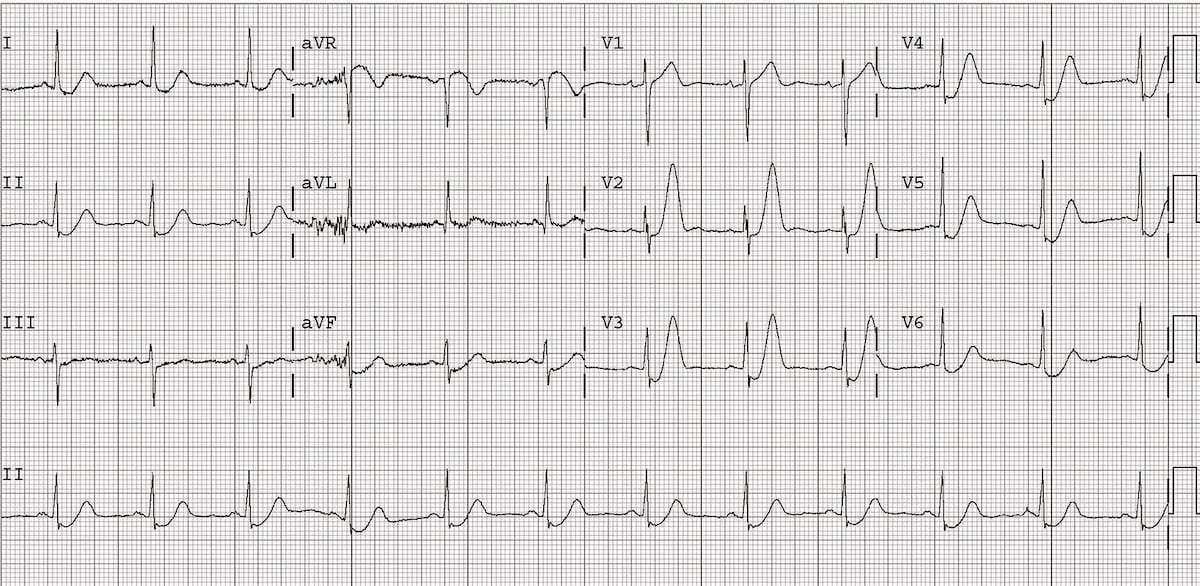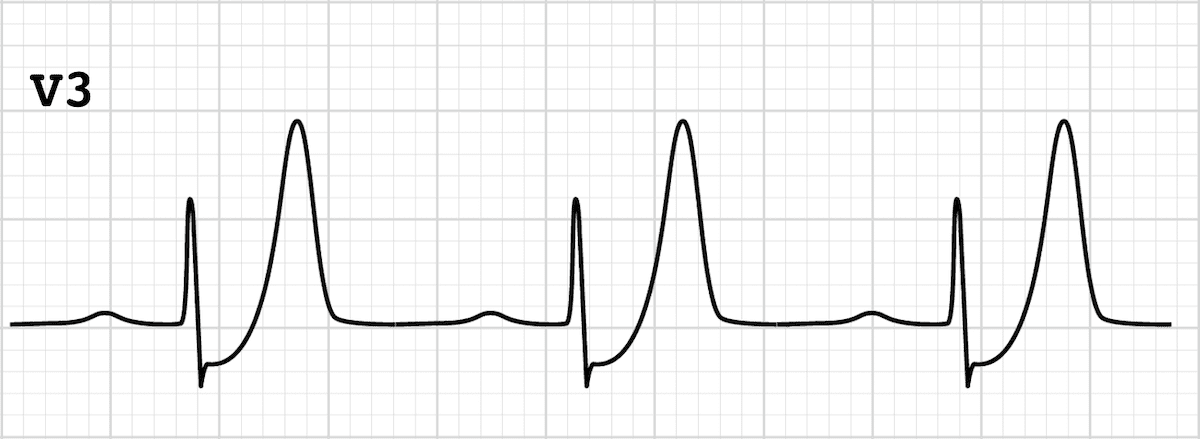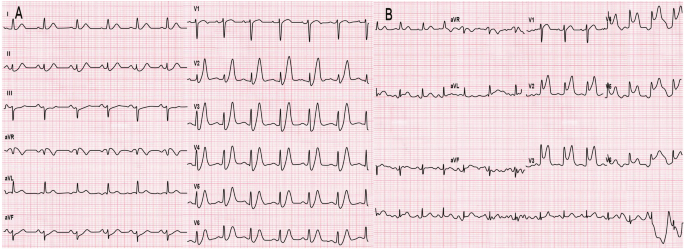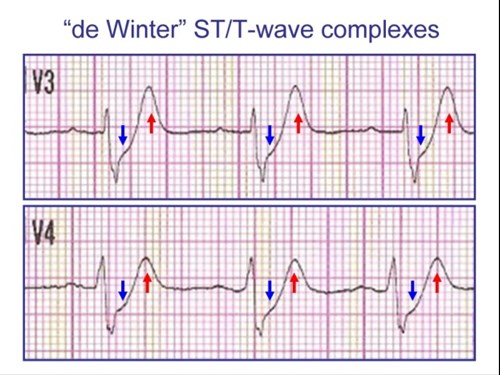First recognized and reported by de Winter et al. Appropriate cardiac cath lab activation.
De Winter St T Waves Ecg Medical Training
Rokos I et al.

. In fact the title was Persistent precordial hyperacute T-waves signify proximal left anterior descending artery occlusion The authors based this idea of persistence. The de Winter ECG pattern was first described in 2008 as an ST elevation equivalent 3 This pattern was shown as a 1-3 mm upsloping ST-segment depression at V 1-V 6 that continued into tall positive symmetrical T waves. Optimizing electrocardiogram interpretation and clinical decision-making for acute ST-elevation myocardial infarction.
Tall often very prominent T waves in the precordial leads. T waves associated with De Winters are often referred to as being. De Winters sign was first described by de Winter et al.
De Winter syndrome is an electrocardiogram ECG pattern related to acute occlusion of the anterior descending artery. The de Winter ECG pattern indicates occlusion of the LAD and is frequently underrecognized by clinicians which increases morbidity and mortality. The de Winter Electrocardiogram Pattern Evolving From Hyperacute T Waves.
Onset to recording the de Winter pattern was 99 79 min. Changes are dynamic as you would expect with ACS see Example 3 below Suspicious for proximal occlusion of the LAD. However it is often unrecognized by physicians.
In 2008 and later replicated in findings by Verouden et al. Most patients showed a J point rise of 1-2 mm at lead aVR mild depression at inferior wall ST segments and normal or. We aimed to investigate the morphology of the De Winter ECG pattern and evaluate the test characteristics of the De Winter pattern for the diagnosis of acute coronary occlusion.
The classic teaching is ST-segment elevation myocardial infarction STEMI is defined as symptoms consistent with acute coronary syndrome ACS new ST-segment elevation at the. The exact mechanism for this ECG pattern is not known. De Winter STT-Waves.
Characterized by 1-3 mm of ST-depression with upright symmetrical T-waves. The heart rate when recording the ECG with de Winter pattern was 74 18 bpm. Two patients who finnaly diagnosed with De Winter syndrome were included in our study.
De Winter sign in ECG is one of the not so uncommon types of presentation for acute anterior wall myocardial infarction. This de Winter ECG pattern is not static but can evolve from hyperacute T waves. The ECG pattern showing 2 mm upsloping ST-segment depression at the J point in the precordial leads with tall and positive symmetric T waves ST-segment elevation of 05 mm in the lead aVR.
Complications of acute aortic dissection AD in the setting of acute myocardial infarction AMI with de Winter sign are relatively rare and physicians may easily miss the diagnosis of AD. De Winter electrocardiograph ECG pattern signifies proximal left anterior descending coronary artery LAD occlusion and extensive anterior myocardial infarction and it is found in about 2 of patients with proximal LAD occlusion. Differentiation of this ECG pattern is essential to refer patients for appropriate and immediate reperfusion therapy.
The maximal amplitude of the STD was 3 2 mm. Is observed in about 2 patients with proximal LAD occlusion. More than 1mm of ST depression in the precordial leads.
De Winter R et al. These patients are suffering occlusion myocardial infarction OMI and require immediate reperfusion therapy. V3 also has ST depression with a hyperacute T-wave very suggestive of de Winters T-waves.
This pattern should be treated as being equivalent to an anterior STEMI. Varón de 80 años sin factores de riesgo cardiovasculares que consulta por dolor de perfil isquémico de 2 h de evolución. The distinct ECG pattern was identified in approximately 2 of patients with LAD stenosis in that study also.
The ST depression persists. It reminded me that many believe due to the assertions in the original de Winters article that de Winters waves are stable. In 2008 as a new electrocardiographic EKG pattern of acute proximal left anterior descending coronary artery LAD occlusion.
Represents approximately 2 of LAD occlusions. El ECG muestra descenso del ST con T simétrica y picuda en precordiales y ascenso del ST en avR fig. First reported by Dutch Professor of Cardiology Robbert J.
Table 1 shows the ECG and angiographic findings of the two groups. El ecocardiograma mostró aquinesia anterior y fracción de eyección del ventrículo izquierdo FEVI global de 35. In 2008 de Winter et al described an ECG pattern suggesting that it should be considered an ST-elevation myocardial infarction STEMI equivalent de Winter Verouden Wellens Wilde 2008 with the potential to predict critical stenosis or occlusion of the left anterior descending coronary artery LAD.
However it is often missed by physicians as well as cardiologists leading to less aggressive initial management. The de Winter electrocardiographic ECG pattern was characterized by upsloping STsegment depressions tall and positive symmetrical T waves in precordial leads. These patients were more likely to be younger and male and tended to have hypercholesterolaemia.
De Winter electrocardiograph ECG pattern is an atypical presentation of acute myocardial infarction AMI due to severe stenosis of the left anterior descending LAD. This is a de Winters T-wave and diagnostic of near occlusion of the LAD. The De Winter ECG pattern has been reported to indicate acute left anterior descending coronary artery occlusion and is often considered to be an ST elevation myocardial infarction STEMI equivalent.
A new ECG sign of proximal LAD occlusion. Very slight 05-1mm ST elevation in lead aVR. ECG abnormality described by de Winter et al.
Now there is no ST elevation in V2 but there is a hyperacute T-wave. ECG characteristics of De Winters T waves include. The incidence rate of De Winter syndrome is rare but still requires much attention from clinicians.
The electrocardiogram ECG is one of the most useful diagnostic studies for identification of acute coronary syndrome ACS and acute myocardial infarction AMI. The de Winter electrocardiogram pattern is a transient electrocardiographic phenomenon that presents at early stage of ST-segment elevation myocardial infarction Clin Cardiol 41 2018 pp. De Winter Rd et al A new sign of proximal lad occlusion NEJM 2008359.
De Winter in 2008 the de Winter ECG pattern is an anterior STEMI equivalent that presents without obvious ST segment elevation. The maximal amplitude of the positive tall T wave was 9 3 mm.

De Winter T Wave Litfl Ecg Library Diagnosis

De Winter Syndrome An Underrecognized Electrocardiography Finding In Myocardial Infarction Journal Of Emergency Medicine

De Winter T Wave Litfl Ecg Library Diagnosis

De Winter T Wave Litfl Ecg Library Diagnosis

De Winter T Wave Litfl Ecg Library Diagnosis
De Winter St T Waves Ecg Medical Training

Evolutionary De Winter Pattern From De Winter Ecg To Stemi A Case Report Bmc Cardiovascular Disorders Full Text

0 comments
Post a Comment